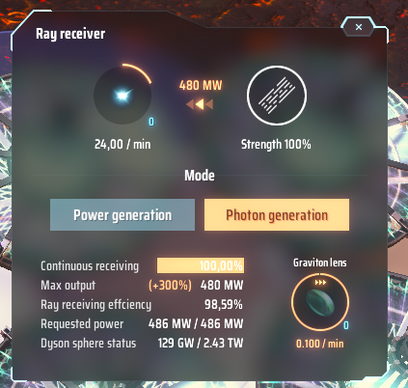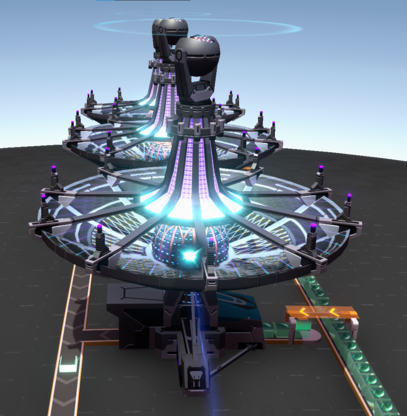Summary
Ray Receivers are used to harvest energy from the Dyson Sphere and the Dyson Swarm. Like Solar Panels, Ray Receivers require direct line of sight to their energy source to receive energy. Additionally, they become more efficient the longer they receive without interruption. They possess two different modes, one to provide energy directly, the other to convert received energy into Critical Photons.
Power Mode
The Power Mode allows the Ray Receiver to receive energy and then provide it to the local energy grid. It starts with 6 MW of power generation and will peak at 15 MW with 100% continuous receiving. If fed with Graviton Lenses the maximum output can reach up to 60 MW, depending of the level of proliferation.
Photon Mode
After researching the Dirac Inversion Mechanism technology, the Ray Receiver can be put in an alternative "Photon" mode where it produces Critical Photons. It starts at 48 MW of receiving, and will ramp up to a maximum of 120 MW. At max efficiency, the Ray Receiver produces 6 Critical Photons per minute. If fed with Graviton Lenses the maximum output can reach up to 480 MW, depending of the level of proliferation.
Graviton Lens
Once the player has researched the Planetary Ionosphere Utilization technology, inserting a Graviton Lens will double* the power conversion of the Ray Receiver. Ray Receivers consume Graviton Lenses at the rate of 0.1 / minute, making them effectively last 10 minutes, regardless of the selected mode or power output.
If the planet has an atmosphere, the Graviton Lens enables the Ray Receiver to collect energy that was reflected off the planet's ionosphere, allowing it to receive energy almost everywhere on the planet, regardless of line of sight. Planets still have a dead spot (the size of which appears to depend on the planet's orbital distance from the star).
*Note that proliferating the Graviton Lens will increase the receiving bonus up to 300%, effectively reducing the amount of Ray receivers required by 75%.
Receiving Efficiency
- The Receiving efficiency decides how much energy is lost due to energy dissipation. The higher the receiving efficiency, the lower the energy dissipation is.
- The Ray Receiver's efficiency can be increased with the Ray Transmission Efficiency upgrade. The upgrades stack multiplicatively.
- The current receiving efficiency can be seen on the right side in the upgrade tab of the research window.
- The the first 6 Upgrades (small ones) reduce the energy loss by 10%, the seventh and the infinite ones (big ones) reduce it by 15%.
- The continuous receiving bonus increases the actual efficiency even further. Although for values between 0% and 100% the math is very complicated, but at 100% continuous receiving it simplifies to a flat 40% decrease of any receiving losses.
- Continuous receiving will ramp up by 5% in 60 seconds, and reach 100% after 20 minutes of uninterrupted receiving.
The maximum receiving efficiency can be calculated as follows:
max receiving efficiency[%] = 100% - 70% * 0.9^small_upgrade_count * 0.85^big_upgrade_countactual receiving efficiency[%] = 100% - 0.6 * solar ray basic energy dissipation[%], wheresolar ray basic energy dissipation[%] = 100% - max receiving efficiency[%]
Example for the Ray Transmission Efficiency level 10:
- Max receiving efficiency:
100% - 70% * 0.9^6 * 0.85^4 = 80.58% - Solar ray basic energy dissipation:
100% - max receiving efficiency = 19.42% - Actual efficiency with 100% continuous receiving:
100% - 0.6 * 19.42% = 88.35%
The actual power draw on the Dyson Sphere can be calculated as such:
dyson_sphere_power_draw = energy_output / (100% - energy_dissipation)
Example:
120 MW energy_outout / (100% - 20% energy_dissipation) = 150 MW dyson_sphere_power_draw
Production Chain
Player Tips & Tricks
- On planets with a low axial inclination, place Ray Receivers at their poles for maximum exposure & efficiency. The poles of these planets are always within line of sight to the Dyson sphere/swarm.
- For planets with higher axial inclination, there is no such sweet spot. With the Planetary Ionosphere Utilization technology, however, the line-of-sight restriction is largely removed as long as the Ray Receivers have a supply of Graviton Lenses.
- Building Ray Receivers inside a Dyson Sphere, even just a single ring of frames at 0° Orbit Inclination, will cause the efficiency bonus to never degrade. This also works for a Dyson swarm as long as it is maintained.
- Ray Receivers cannot be belted into each other. To actually extract Critical Photons and insert Graviton Lenses, a setup as seen in the third picture on the right is required.








































































































































































